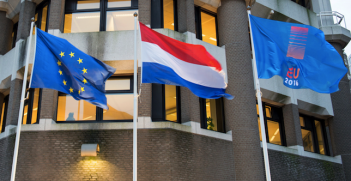Space Oddity: Contested and Congested Commons

Outer space is increasingly seen as contested, congested and competitive. All nations need to do what they can to protect and preserve the space environment.
Outer space is the high ground of diplomacy and is now accepted as the fourth domain of warfare (after land, maritime and air domains and with cyberspace increasingly accepted as the fifth domain). Military strategists, defence planners, and the men and women of the armed forces face a much more complex task than ever before in deciding how to imagine, prepare for and execute future conflict.
Strategists and policy makers increasingly speak of space as being contested, congested and competitive.
There are currently 1,305 operating satellites in orbit with 549 under the control of the US, 131 operated by Russia and 142 by China. As such, the United States remains the world’s major space power.
Three classes of satellites, operating in four types of orbits, provide services on which the entire global economy now depends:
- Communications satellites, many in Geostationary Earth Orbits (GEO), provide myriad services to remote communities, ships at sea and aircraft.
- Global Navigation Satellite Systems (GNSS), mostly operating in Medium Earth Orbits (MEO). The US Global Positioning System (GPS) is the best known GNSS system but others are operated or are being developed by Russia, China, the European Union, Japan and India.
- Earth observation satellites typically operate in the Low Earth Orbits (LEO) mostly in highly-inclined orbits, meaning that their orbits take them across the poles. Some of these satellites perform classified missions for the governments that own them. Others have broad civil and commercial application.
- The fourth type of orbit is known as an elliptical orbit and is used by some communications satellites as well as some satellites that gather electronic intelligence.
Beyond the working satellites, there are more than 20,000 pieces of space debris in LEO that are actively tracked by the United States Air Force (USAF) and others. These are all at least the size of a cricket ball. These objects include an astronaut’s glove, hand tools and much larger items such as spent rocket casings. In addition there are hundreds of thousands of smaller objects that are too small to track, including flecks of paint and shards of metal. The risk of these objects colliding, especially over the poles where so many of the LEO orbits converge, is growing and the shared concern of space-faring nations is that the likelihood of a runaway chain reaction of collisions is increasing rapidly to dangerous levels.
Further pressure is coming onto the LEO environment as a result of the plans by several companies to place into LEO very large constellations of hundreds and even thousands of small satellites. The implications for space traffic management and for debris monitoring and mitigation are causing ripples of concern internationally but so far this has not translated into concrete action.
Some LEO orbits may well become unusable within 10-15 years unless concerted multi-national action is taken to clean up the debris. Beyond the not inconsiderable technical challenges of how to remove debris there are possibly more challenging political, legal and diplomatic challenges which can be summarised in the following way: the space garbage truck of one nation may well be viewed as a space weapon by another nation. Unfortunately careful efforts over the past five or so years to build trust and confidence among the major space powers that is both necessary and sufficient for them to agree on what debris to remove, how, in what order and when, have for the moment come to a grinding halt.
Problems are not just confined to LEO. GEO is in trouble as well. Satellites in GEO are travelling in an anti-clockwise direction around the Earth about 36,000km above the Equator. From Earth, which is also rotating about its axis in an anti-clockwise direction, satellites in GEO appear stationary. Satellites in GEO are allocated “slots”. Some are weather satellites, others gather electronic intelligence and others are used for ballistic missile warning. Most however, are communications satellites and many of them are commercial. To avoid unwanted and unintended radio interference, satellites in GEO need to be quite some distance apart and there is a limit to the number of slots. There are few spare or unoccupied slots left. A second problem related to radio spectrum is that some of the radio frequencies that are best for satellite communications are also highly sought after by mobile phone operators whose businesses and growth prospects are considerably greater than are those of satellite operators. Satellite radio spectrum is allocated by the International Telecommunications Union (ITU) and both the ITU and domestic spectrum regulators are under increasing pressure to reduce the spectrum allocated to satellite operators in favour of burgeoning terrestrial mobile markets.
Since the Cold War, the potential for satellites to support conventional military forces has been clearly understood by both the United States and the Soviet Union. Both nations and others since have invested in satellites for military and national security purposes. Space has always been militarised. However, so far as we know, space has not been weaponised in the sense that weapons have been placed in space.
Certainly there are ground-based weapons systems, known as anti-ballistic missiles (ABMs) that have been developed and tested to detect and destroy ballistic missiles. Other systems have been developed to degrade and even destroy satellites in orbit. Called anti-satellite or ASAT weapons, these systems are proliferating. Once the preserve of just the United States and Russia, China has conducted successful ASAT tests and India has indicated that it is developing an ASAT capability as well.
The basic law of space is the Outer Space Treaty that came into force in 1967. It has served space-faring nations well enough in the past but its utility going forward is under question. The profoundly dual use nature of space, the enormous dependency that the global economy has on space-based services and the impacts of miniaturisation are combining to create challenges not just for space-faring nations but for all nations because of their reliance on services from space.
We need to think of satellites as providing virtual international critical infrastructure and all nations need to do what they can to protect and preserve the space environment.
Australia can play a role in these efforts. From 25-29 September 2017, the world’s largest space conference, the International Astronautical Congress, is being held in Adelaide with more than 3,000 people expected to attend the Congress from all parts of the world.
Brett Biddington AM, is the founder and principal of a Canberra-based consulting company. He has adjunct professorial appointments at RMIT University in Melbourne and at Edith Cowan University in Perth. This article can be republished under a Creative Commons License.





